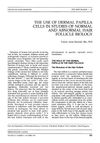glycoprotein that inhibits TGF-β and promotes hair growth by antagonizing activin
signaling protein that, when suppressed, may grow hair by reducing inflammation and stem cell loss
mitochondrial pyruvate carrier (MPC) inhibitor by Pelage in early trials
a signaling molecule from dermal papilla cells being actively researched
chemical from L'Oreal that encourages hair to enter growth phase



